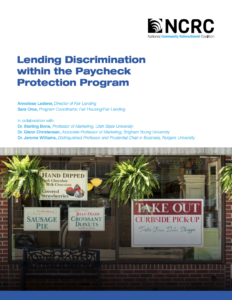 Lending Discrimination within the Paycheck Protection Program
Lending Discrimination within the Paycheck Protection Program
National Community Reinvestment Coalition
First published July 2020
Since March 2020, businesses in the U.S. have been struggling to continue operations in the face of a global pandemic. The COVID-19 pandemic has resulted in a recession because of the widespread closures of non-essential businesses enacted to reduce the spread of the virus. Even as things begin to reopen, people are less likely to go out due to possible health risks. In response, Congress passed the Coronavirus Aid, Relief, and Economic Security (CARES) Act which created the Paycheck Protection Program (PPP). The PPP is a lending program that provides money, in a potential grant format, to small businesses to help them weather the economic effects of the pandemic. The majority of the loan needs to be allocated for employee salaries and then the remainder can be used for other business expenses like rent and loan payments. The purpose of this study was to determine whether the disparities in small business lending we have detected prior to the COVID-19 pandemic continued with implementation of the PPP program.
There have been problems with the implementation of the PPP as there were concerns that the banks were initially primarily working with current clients and prioritizing their larger clients over smaller clients so that they could receive larger processing fees. In addition, the Small Business Administration (SBA), for at least the beginning phase of PPP, did not collect borrower demographic information so there was little information available regarding who actually received loans or if businesses received the full funding they requested.
In part, because of these data limitations, the role of lending discrimination in the allocation of the PPP funding has not been fully studied. The National Community Reinvestment Coalition, in collaboration with our academic partners, conducted matched-pair audit testing of financial institutions in Washington, DC. Matched-pair testing is a method used to detect discrimination by using a pair of testers with different races (or other protected class) but similar profiles as a way to determine differences in treatment from financial institutions. This testing, where Black and White applicants with similar credit characteristics applied to a lender in the same time period, was a continuation of the work that we conducted in 2017, 2019 and earlier in 2020 related to discrimination in small business lending. The matched-pair testing provides insight into treatment between testers both across the marketplace and between individuals.
Download Resource